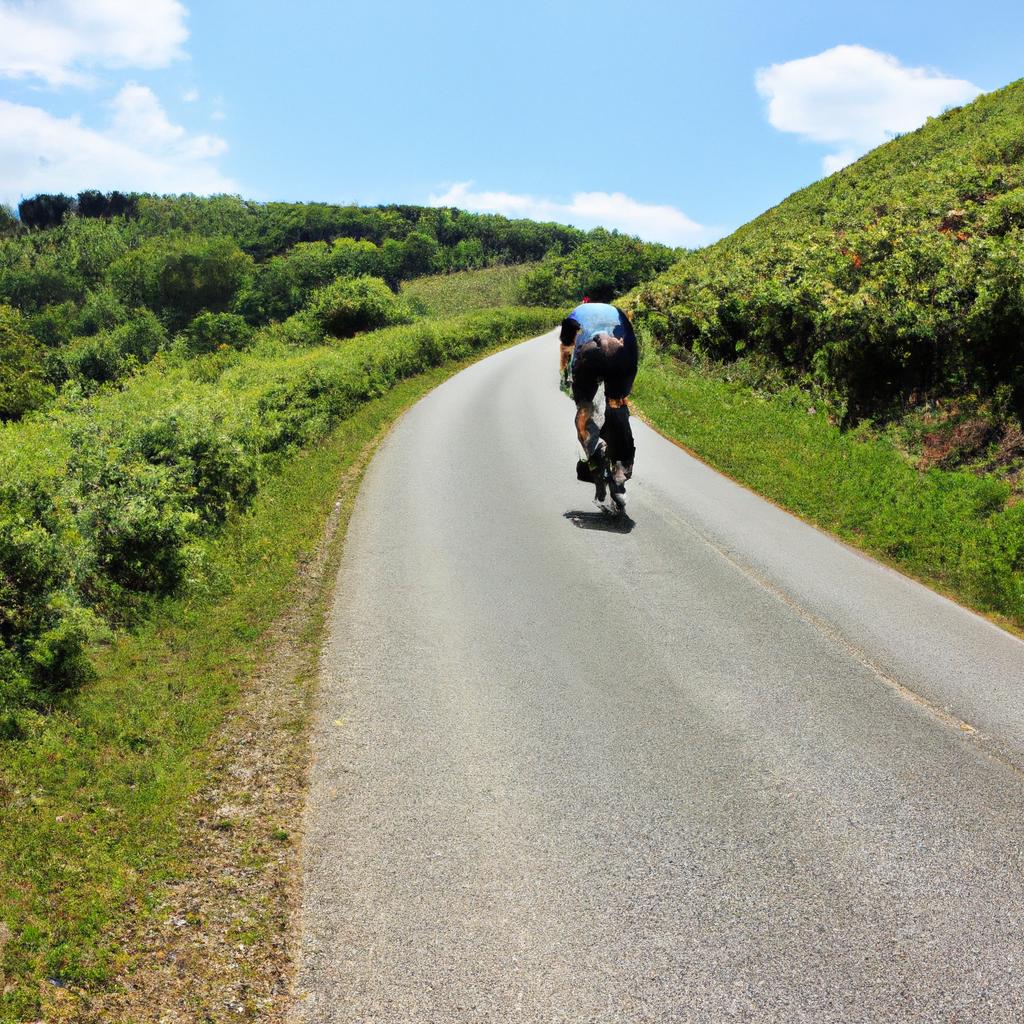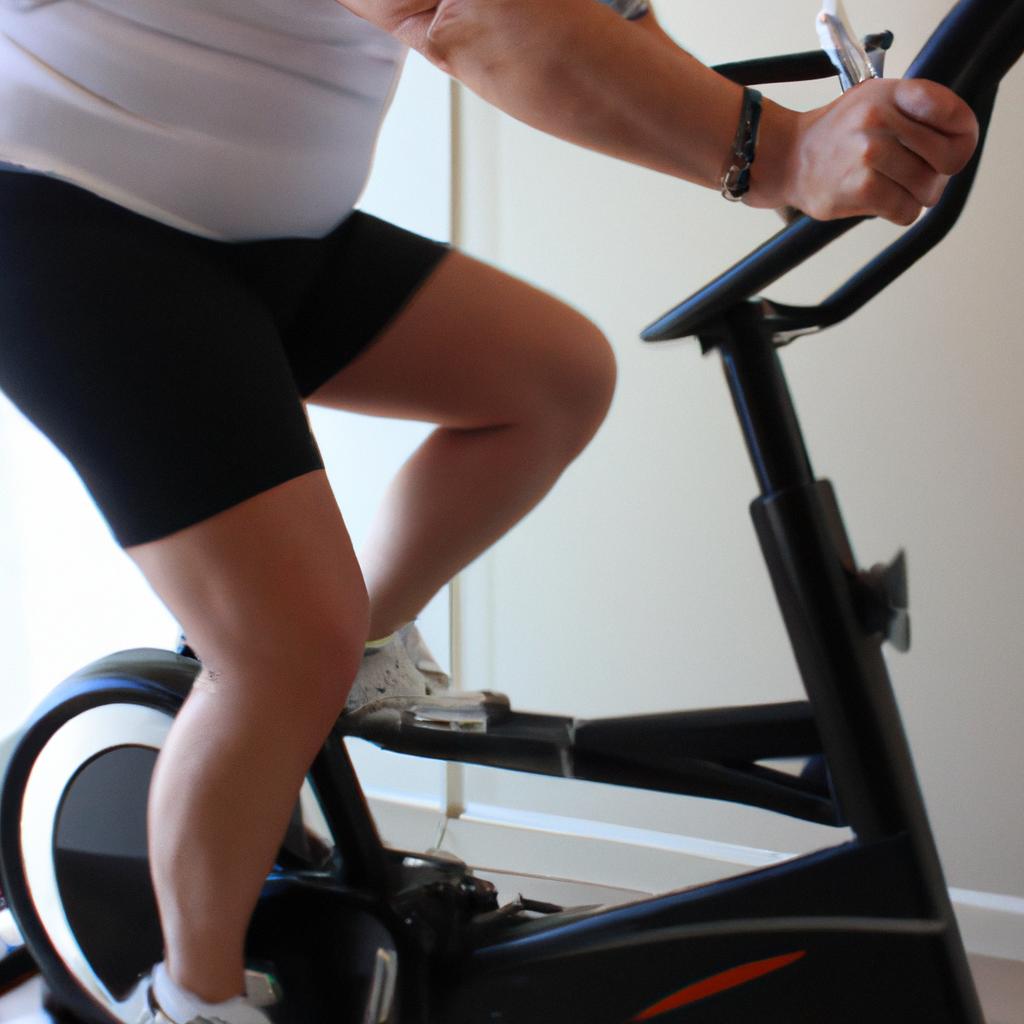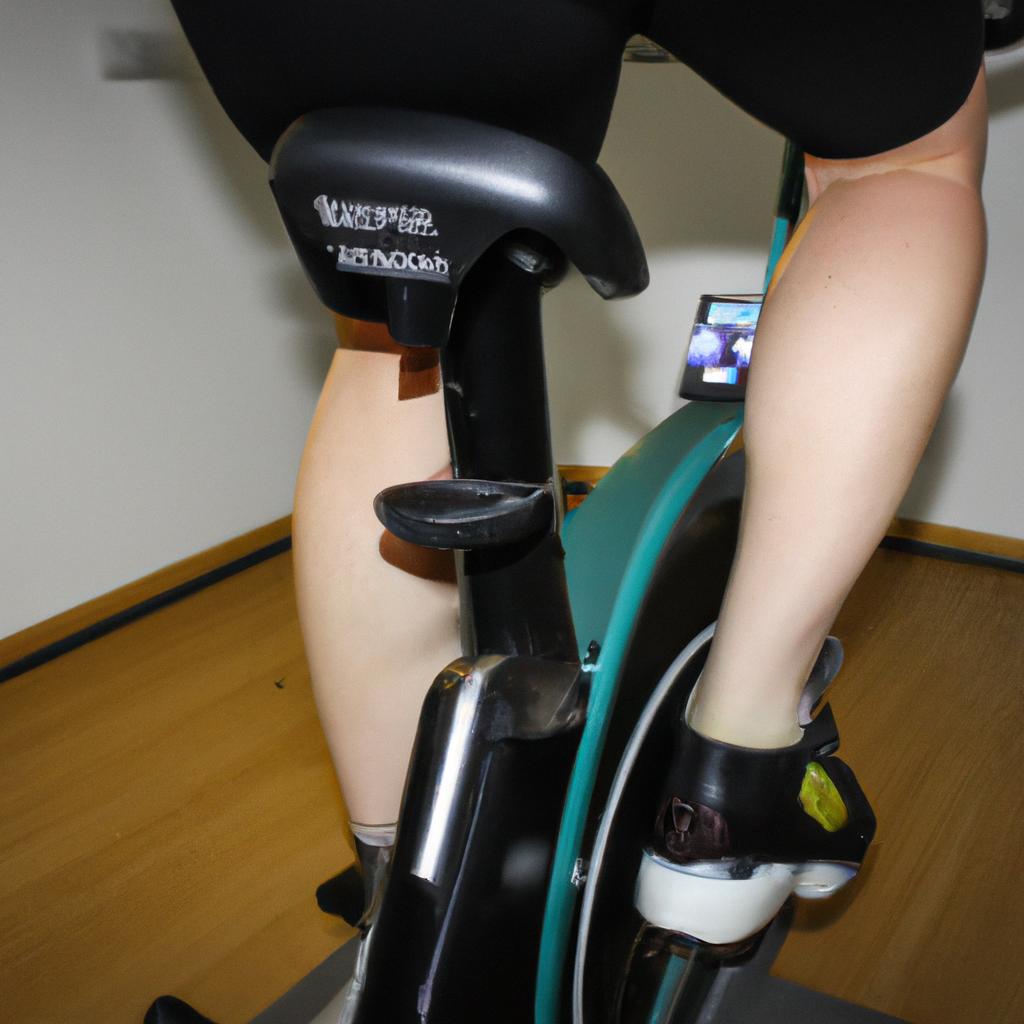Hill Climbing Strategies: Sports Cycling Training Tips

Hill climbing is a challenging aspect of sports cycling that requires specific training strategies to enhance performance. Whether it be conquering steep inclines during competitive races or tackling hilly terrains on endurance rides, cyclists need to develop effective techniques to optimize their hill climbing abilities. This article aims to provide valuable insights into various hill climbing strategies and training tips for sports cyclists.
Consider the case of Sarah, an experienced cyclist who participates in long-distance road racing events. Despite her overall prowess in cycling, Sarah often finds herself struggling when faced with uphill sections of the racecourse. She recognizes the importance of improving her hill climbing skills as this can significantly impact her overall race performance. Through targeted training strategies and consistent practice, Sarah hopes to overcome these challenges and become a more proficient climber. Examining Sarah’s journey serves as a compelling example to explore the importance of implementing specialized training methods specifically designed for enhancing hill climbing capabilities in sports cycling athletes.
As such, this article will delve into different aspects related to hill climbing strategies for sports cycling enthusiasts. It will discuss essential factors like physical conditioning, mental preparation, gear selection, pacing techniques, and tactical decision-making during climbs. By understanding and applying these key principles, cyclists can improve their ability to tackle hills effectively and gain a competitive advantage over their peers.
Physical conditioning is a crucial aspect of improving hill climbing abilities. Cyclists should focus on developing both muscular strength and cardiovascular endurance. Incorporating strength training exercises that target the legs, core, and upper body can help build the necessary power and stability required for tackling steep inclines. Additionally, incorporating high-intensity interval training (HIIT) sessions into your cycling routine can improve cardiovascular fitness, enabling you to sustain higher intensities during climbs.
Mental preparation plays an equally important role in conquering hills. Developing mental toughness and a positive mindset will help you push through physical discomfort and overcome self-doubt during challenging climbs. Visualization techniques can be helpful in mentally rehearsing successful hill climbs before actually attempting them. Setting achievable goals and focusing on incremental progress can also boost confidence levels.
Gear selection is another critical factor in optimizing hill climbing performance. Having the right gear ratios on your bike can make a significant difference when it comes to maintaining an efficient cadence while ascending. Lower gear ratios allow for easier pedaling at a higher cadence, reducing muscle fatigue and improving overall efficiency. Experimenting with different gear combinations during training rides will help you find the optimal setup for various terrain gradients.
Pacing techniques are essential for conserving energy during long climbs. It’s crucial to find a sustainable rhythm that allows you to maintain a steady effort throughout the ascent without burning out too quickly. Start by setting a comfortable pace at the beginning of the climb, gradually increasing intensity as you progress if needed. Avoid going all-out at the start, as this can lead to premature exhaustion later on.
Tactical decision-making during climbs involves understanding the terrain and making strategic choices based on factors such as gradient variations, wind conditions, road surface quality, and competitors’ positions. Learning how to read the road ahead can help you anticipate changes in gradient or select more favorable lines that minimize energy expenditure. Strategically using drafting techniques behind other riders can also provide temporary relief during steeper sections.
In conclusion, improving hill climbing abilities in sports cycling requires a multifaceted approach involving physical conditioning, mental preparation, gear selection, pacing techniques, and tactical decision-making. By incorporating these strategies into your training routine and consistently practicing on challenging terrain, you can enhance your hill climbing skills and ultimately improve your overall performance as a cyclist.
Setting realistic goals
H2: Setting Realistic Goals
Imagine a cyclist named Sarah who has just started training for an upcoming hill climbing competition. She is ambitious and highly motivated, eager to conquer even the steepest terrains. However, in her enthusiasm, she fails to set realistic goals that align with her current fitness level and capabilities. This mistake ultimately leads to frustration and setbacks in her training journey.
To avoid such pitfalls, it is crucial for sports cyclists like Sarah to set achievable goals at the outset of their training program. First and foremost, this involves assessing one’s current physical condition and skill level objectively. By recognizing individual strengths and weaknesses, athletes can tailor their goals accordingly, ensuring they are both challenging yet attainable.
When setting cycling training goals, it is important to consider various factors that contribute to performance enhancement. These may include improving endurance, increasing power output, refining technique, or enhancing mental focus during uphill challenges. To help illustrate the significance of goal setting in sports cycling training, let us explore some key benefits:
- Enhanced motivation: Clear objectives provide athletes with a sense of purpose and direction throughout their training journey.
- Improved focus: Well-defined goals allow cyclists to concentrate on specific areas requiring development rather than wasting energy on unrelated aspects.
- Measurable progress: Establishing concrete targets enables regular evaluation of performance growth over time.
- Reduced risk of burnout: Attainable milestones prevent individuals from pushing themselves too hard too soon, reducing the likelihood of exhaustion or injury.
| Goal | Objective | Target Date |
|---|---|---|
| Increase | Improve average speed by 1 mph | June 2023 |
| Endurance | Complete a century ride (100 miles) | August 2023 |
| Technique | Master effective gear shifting on steep inclines | October 2023 |
| Mental Focus | Maintain concentration during climbs | December 2023 |
In conclusion, setting realistic goals is a fundamental step in sports cycling training. By establishing achievable objectives based on one’s current fitness level and considering various performance factors, athletes can enhance motivation, improve focus, track progress, and reduce the risk of burnout.
(Note: Transition sentence without using “step”) Looking ahead to our exploration of improving strength and endurance…
Improving strength and endurance
Setting realistic goals is an essential aspect of sports cycling training. By establishing achievable targets, athletes can maintain focus and motivation throughout their journey. For instance, let’s consider a hypothetical situation where a cyclist aims to improve their hill climbing performance by reducing their time on a challenging uphill route. This specific goal provides the athlete with a tangible objective to work towards and allows them to track progress effectively.
To enhance strength and endurance for hill climbing, cyclists can employ various strategies. Firstly, incorporating interval training into their regimen can be highly beneficial. Interval training involves alternating between periods of high-intensity efforts and recovery periods, allowing the body to adapt and become more efficient in utilizing energy stores. Secondly, including resistance training exercises such as squats or lunges helps develop leg muscles necessary for powering through steep climbs. Additionally, cross-training activities like swimming or running provide overall cardiovascular conditioning which supports improved performance during hill climbs.
Here are some important tips for enhancing strength and endurance specifically geared towards hill climbing:
- Maintain proper form while riding: Ensure that your posture is correct, engaging core muscles to support your back.
- Focus on cadence: Work on finding an optimal pedaling rhythm that allows you to efficiently transfer power to the pedals.
- Gradually increase intensity: Start with less challenging hills and gradually progress to steeper inclines as your fitness improves.
- Monitor heart rate: Utilize heart rate monitors to gauge intensity levels during training sessions and ensure they align with specific objectives.
Additionally, it may be helpful to refer to the following table showcasing different types of interval training sessions:
| Type of Interval Training | Duration (minutes) | Intensity Level |
|---|---|---|
| High-intensity intervals | 2 – 3 | High |
| Recovery intervals | 1 – 2 | Low/Moderate |
By implementing these strategies and adhering to appropriate guidelines, cyclists can improve their hill climbing abilities and achieve significant progress in their training. Developing proper climbing technique is the subsequent focus area that will be explored further.
Developing proper climbing technique
Section H2: Developing proper climbing technique
Transitioning from improving strength and endurance, developing proper climbing technique is crucial for sports cyclists looking to conquer challenging terrains. By mastering effective techniques, athletes can optimize their performance on uphill climbs, increasing speed and efficiency while reducing fatigue. Let’s explore some key strategies that can help riders enhance their climbing abilities.
One way to improve climbing technique is through maintaining a consistent cadence throughout the ascent. This involves finding an optimal rhythm of pedal strokes that suits your fitness level and the gradient of the hill. For example, imagine a cyclist named Alex attempting to climb a steep mountain pass. With each stroke, Alex maintains a steady pace, neither overexerting nor spinning too fast. By adopting this approach, Alex utilizes muscular energy efficiently and avoids premature exhaustion.
To further enhance climbing capabilities, it is essential to focus on body positioning. A correct posture aids in distributing weight effectively between the front and rear wheels for improved traction and stability. Cyclists should shift their weight forward slightly when ascending steeper gradients or standing up on the pedals during intense efforts. Additionally, keeping a relaxed upper body minimizes unnecessary tension and allows for better bike control.
Implementing these strategies can be highly beneficial for sports cyclists seeking to excel in uphill challenges:
- Maintain a consistent cadence: Find a suitable rhythm by adjusting pedaling speed according to terrain conditions.
- Focus on body positioning: Shift weight forward when tackling steeper sections and maintain a relaxed upper body.
- Utilize appropriate gearing: Select gear ratios that enable smooth transitions between different inclines.
- Practice breathing techniques: Develop controlled breathing patterns to maximize oxygen intake during demanding climbs.
Table 1 below illustrates how implementing these strategies can contribute to improved performance:
| Strategy | Benefits |
|---|---|
| Consistent cadence | Energy conservation |
| Body positioning | Enhanced stability |
| Appropriate gearing | Smooth transitions between inclines |
| Breathing techniques | Improved oxygen intake and reduced fatigue |
In conclusion, developing proper climbing technique is a fundamental aspect of sports cycling training. By maintaining a consistent cadence, focusing on body positioning, utilizing appropriate gearing, and practicing breathing techniques, athletes can optimize their uphill performance.
Transitioning into the subsequent section about “Incorporating interval training,” cyclists can add variety to their training routine while targeting specific aspects of fitness for further improvement.
Incorporating interval training
Building on the foundation of developing proper climbing technique, cyclists must also consider the importance of fueling strategies to optimize their performance during hill climbs. By implementing effective nutritional practices, athletes can enhance their endurance and sustain energy levels throughout rigorous training sessions and races. Let’s explore some key aspects of fueling strategies that can support sports cycling training.
One important aspect is ensuring an adequate intake of carbohydrates before a hill climb. For instance, imagine a cyclist preparing for a challenging mountain stage in a professional race. To maintain optimal glycogen stores, they consume a pre-ride meal rich in complex carbohydrates such as whole grains, fruits, and vegetables. These nutrient-dense choices provide sustained energy release during prolonged efforts while avoiding blood sugar spikes that may result from consuming simple sugars.
To further enhance performance during hill climbs, it is essential to prioritize hydration. Dehydration can lead to decreased muscular function and impaired cognitive abilities, negatively impacting overall cycling performance. Cyclists should aim to drink fluids regularly before, during, and after rides to replenish lost electrolytes and prevent fatigue. Additionally, incorporating electrolyte-rich beverages or supplements can aid in maintaining fluid balance and optimizing muscle contraction.
Integrating these fueling strategies into your training routine can contribute significantly to improved hill climbing ability:
- Consume carbohydrate-rich meals or snacks 2-3 hours prior to longer rides.
- Hydrate consistently with water or electrolyte-enhanced drinks throughout the ride.
- Consider utilizing sports gels or bars containing easily digestible carbohydrates as mid-ride fuel sources.
- Monitor urine color as an indicator of hydration status; darker urine suggests inadequate fluid intake.
By emphasizing proper nutrition and hydration techniques like those mentioned above, cyclists empower themselves with valuable tools for conquering demanding hill climbs effectively. The table below summarizes some key recommendations for fueling strategies:
| Fueling Strategies | Benefits |
|---|---|
| Eating carbohydrate-rich meals | Sustained energy release |
| Consuming electrolyte-enhanced beverages | Optimal fluid balance and muscle function |
| Incorporating mid-ride fuel sources | Continuous supply of easily digestible carbohydrates |
With a solid foundation in climbing technique and effective fueling strategies, we can now explore the significance of optimizing gear selection during hill climbs.
Optimizing gear selection
Building on the importance of interval training, incorporating appropriate recovery strategies is crucial for maximizing sports cycling performance. By allowing the body to rest and repair, athletes can ensure optimal physical condition during training sessions and races. This section will discuss various recovery techniques that can aid in enhancing performance and preventing injuries.
Paragraph 1:
For instance, one hypothetical scenario involves a professional cyclist who recently completed an intense interval training session. To facilitate efficient recovery, this cyclist could implement several key strategies. Firstly, engaging in active recovery exercises such as light jogging or swimming can help increase blood circulation and flush out metabolic waste products. Additionally, utilizing self-massage tools like foam rollers or massage balls can target specific muscle groups, promoting relaxation and reducing muscular tension. Lastly, proper nutrition plays a vital role in recovery; consuming a balanced meal rich in carbohydrates and protein within the first hour post-exercise helps replenish glycogen stores and supports muscle repair.
Bullet point list (markdown format) highlighting key recovery strategies:
- Engage in low-intensity activities for active recovery
- Utilize self-massage tools to reduce muscle tension
- Consume a balanced meal with carbohydrates and protein after exercise
- Prioritize adequate sleep to support overall recovery
Paragraph 2:
To provide further insights into effective recovery methods used by cyclists worldwide, consider the following table showcasing different techniques alongside their benefits:
| Recovery Technique | Benefits |
|---|---|
| Compression garments | Enhances blood flow |
| Cold water immersion | Reduces inflammation |
| Stretching | Promotes flexibility |
| Sleep | Supports hormone regulation and tissue repair |
Table demonstrating various recovery techniques utilized by cyclists.
Paragraph 3:
By implementing these evidence-based recovery strategies consistently into cycling training routines, athletes stand to gain numerous advantages. Not only do these practices enhance physical recuperation but also contribute to injury prevention, allowing athletes to maintain a consistent training schedule. As such, monitoring progress and adjusting training accordingly becomes imperative in order to continue progressing towards optimal performance.
Moving forward, the following section will delve into the importance of monitoring progress and making necessary adjustments during sports cycling training. By adopting a proactive approach to tracking one’s performance, cyclists can make informed decisions that optimize their training routines without risking overexertion or plateauing in development.
Monitoring progress and adjusting training
Hill Climbing Strategies: Sports Cycling Training Tips
Having discussed the importance of optimizing gear selection for hill climbing in the previous section, let us now turn our attention to monitoring progress and adjusting training. By implementing effective strategies in these areas, cyclists can further enhance their performance when faced with challenging uphill terrains.
Monitoring progress plays a crucial role in evaluating the effectiveness of training programs and identifying areas that require improvement. For instance, consider an amateur cyclist who has been following a specific hill climbing training regimen for several weeks. To monitor their progress, they regularly track key metrics such as average speed, heart rate variability, power output, and perceived exertion. Comparing this data over time allows them to observe any positive or negative trends and make necessary adjustments accordingly.
To assist cyclists in effectively monitoring their progress while ascending hills, here are some recommended practices:
- Utilize cycling GPS devices or smartphone applications that provide real-time feedback on distance covered, elevation gained, and other relevant metrics.
- Keep a detailed training log documenting each ride’s duration, intensity level, and perceived effort.
- Conduct periodic fitness tests to measure improvements in endurance capacity and power output.
- Seek professional guidance from coaches or sports scientists who can analyze collected data and offer personalized recommendations for better performance.
In addition to tracking progress, adjusting training methods based on individual goals is essential for continual improvement. The table below offers three different approaches tailored towards varying objectives:
| Training Approach | Objective | Key Focus Areas |
|---|---|---|
| Endurance-based | Enhancing aerobic capacity | Long-duration climbs |
| Strength-focused | Improving muscular power | Steep inclines |
| Interval-training | Boosting anaerobic threshold | Short bursts of intense efforts |
These approaches serve as starting points but should be adjusted according to individual strengths and weaknesses. By incorporating a variety of training methods and periodically reassessing progress, cyclists can optimize their hill climbing performance over time.
By diligently monitoring progress and adapting training strategies based on individual goals, cyclists aspiring to conquer challenging uphill terrains can maximize their potential. Remember that the journey towards becoming a proficient hill climber is an ongoing process, requiring commitment and dedication. Therefore, it is imperative to remain consistent in tracking progress and making adjustments as necessary in order to achieve optimal results.






